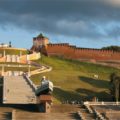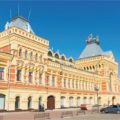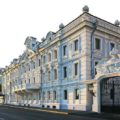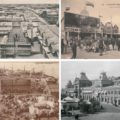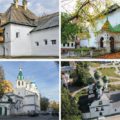Over the city’s eight-century history, Nizhny Novgorod has played at least three major roles. It originated as a frontier fortress, then was later considered the “moneybag” of Russia, thanks to the famous Nizhny Novgorod fair. In the twentieth century, Nizhny Novgorod transformed into a city of giant factories for manufacturing both civilian and military products.
The Kremlin: A Mighty Fortress
The 16th-century Kremlin serves as a reminder that Nizhny Novgorod was once known as the shield of Russia. Construction on the Kremlin took place between 1508 and 1515, led by Italian architect Pietro Francesco (Petr Fryazin). The architect was charged with a very difficult task, as the Kremlin’s clocktower wall sharply descended down a tall mountain with huge ledges.
The battlements of the walls are rectangular and topped with dovetail brick patterns, reminiscent of the two-horned battlements of both Italian fortresses and the Moscow Kremlin. Every fifth battlement has a loophole for shooting an arquebus, bow, or crossbow. From the inside, each loophole has a triangular niche that allowed shooters to freely move their weapons and assume a comfortable position.
If the enemy was approaching, defenders could shoot them from the loopholes located at the very bottom of the wall. In addition, any enemy who managed to break through to the wall was met with a deadly side shooting from the towers, which extended significantly beyond the wall line to provide an excellent defensive advantage. These towers were constructed based on the latest developments in international military science of the time. Offset towers did not block the combat passage, thereby allowing defenders to move quickly and freely along the walls.
After several centuries of service, the Kremlin fell into disrepair. However, in 1896, the main tower (Dmitrievskaya) was reconstructed in preparation for the All-Russian Industrial and Art Exhibition, based on designs by architect Nikolai Sultanov. This reconstruction provided the tower with its modern-day look and made it one of the symbols of the city. Unfortunately, the rest of the towers and walls remained in a sorry state. In 1949, large-scale restoration works began on the Nizhny Novgorod Kremlin, directed by architect Svyatoslav Agafonov. Thanks to his project, this remarkable monument of medieval architecture was given new life. Today, it is the main attraction in Nizhny Novgorod.
17th-Century Stonework: the Symbol of the City’s Golden Age
In the 16–17th centuries, the national borders expanded far beyond Nizhny Novgorod. Conveniently located at the confluence of the Oka and the Volga, two large navigable rivers, Nizhny Novgorod became a large trading city. From the mid to late 17th century, grandiose stone constructions reflected the economic prosperity of the city.
Above all, stone was used for the construction of churches. Today, the oldest church building in Nizhny Novgorod is the Church of Saint Michael the Archangel in the Kremlin, which holds the ashes of Kuzma Minin. The church is an excellent example of tent-roof architecture. It was built in 1631 in gratitude to the people of Nizhny Novgorod for assembling the home guard that defeated the Poles in 1612.
The construction of tent-roof churches lost popularity under Tsar Alexei Mikhailovich (March 9, 1629 — January 29, 1676). From then on, churches were crowned only with domes or cupolas. The Church of the Myrrh-Bearing Women, built in 1649, is a prime example of this style of architecture. Here, the bell tower, the refectory, and the five-cupola church itself are all aligned from west to east, representing a single whole. This type of church building is known as “ship design”. In fact, the Church of the Myrrh-Bearing Women in Nizhny Novgorod was the first church of this type in the history of old Russian architecture.
In 1672, industrialist Afanasy Olisov erected the Assumption Church on Ilinskaya Hill. This elegant five-cupola church has a unique “four-faced bochka” (barrel) roof in the form of a half-cylinder with a pointed upper part, similar to the keel of a ship. This type of “barrel” roof is common for old Russian wooden buildings, but much rarer in stone architecture. The Assumption Church is one of a kind: it has two intersecting half-cylinders, giving the roof four pediments (“faces”). Nearby, Olisov built a stone house for himself. This house also features a barrel-shaped roof over the porch, which is made out of wood.
Around 1699–1702, the rich salt industrialist Grigoriy Stroganov erected the Church of Nativity of the Most Holy Mother of God. The Stroganov Church still sparks the admiration of Nizhny Novgorod locals and guests alike, thanks to its luxurious white-stone ornamentation and the splendor of its multi-colored domes.
Not only is the church a stunning example of Stroganov Baroque; remarkably, the first European-style tower clock in Russia was installed in its bell tower. Unlike Western European clocks, old Russian clocks had a spinning dial, which was called a “pointing circle”. The arrow, representing a sunbeam, did not move. The Spasskaya Tower in the Moscow Kremlin once featured a similar clock. In the Stroganov clocks, just like in modern ones, the hand moves while the dial stays still. This clock still adorns the bell tower to this day. It has a stone circle around the dial with the numbers one to seventeen carved in old style Russian numbers (written in capital Roman letters). At the time, all Russian clocks were divided into seventeen hours to represent the length of the longest day of the year.
The Moneybag of Russia
The city was given the moniker “the Moneybag of Russia” in the 19th century, thanks to the famous Nizhny Novgorod fair. Among the goods sold, iron was in great demand, and the Rukavishnikov family who traded it were some of the richest people in the city. This merchant family built a palace with a magnificent marble staircase on the embankment of the Volga River. To bring their fanciful fantasies to life, the Rukavishnikovs recruited local architect Robert Kilevein and his gifted assistant Petr Boytsov, as well as sculptor Mikhail Mikeshin, the mastermind behind the famous Millennium of Russia monument in Novgorod. The sculptor adorned the facade of the building, completed in 1877, with the mighty figures of Atlanteans, which supported the elegant stone balcony above. Caryatids were erected along the walls between the windows of the second and third floors. The entrance porch was decorated with iron castings, a characteristic sign of eclecticism in a unique Nizhny Novgorod style.
Thirty years later, the Rukavishnikovs invited Fyodor Schechtel, the king of Russian Art Nouveau, to Nizhny Novgorod to design the Rukavishnikov tenement house. Constructed in 1908–1910, the building was made with new kinds of finishing materials, typical for Art Nouveau of the time. In particular, Schechtel used white glazed tiles for the facade cladding. A huge glass window was installed on the first floor and the facade was decorated with art from famous sculptor Sergey Konenkov, cast-iron statues of a worker and a peasant woman, personifying industry and agriculture.
A Socialist City
During the first five-year plans, a number of major industrial enterprises appeared in Nizhny Novgorod. Then, in 1932, the city was given a new name: Gorky. The most famous factory in the city was the Gorky Automobile Plant. A special city was even constructed on the left bank of the Oka River just for its employees. This area was named Sotsgorod, or Socialist City. Throughout the 1930s, it became a test site for bold architectural experiments.
For example, building block #4 of Sotsgorod (by architect Ilya Golosov) is a huge structure made of six adjoining buildings, each five to eight stories high. It has 55 entrances. The courtyard can be accessed through one of seven giant arched openings.
Building block # 8 of Sotsgorod is considered a monument of federal significance. The jewel of the building is known as the Radius House. It was designed and built in 1935–1937 by architects Nikolai Polyudov and Nikolai Krasilnikov from the Vesnin brothers workshop of innovators.
The Most Famous Citizen
Locals in Nizhny Novgorod take great pride in their famous former inhabitants, such as inventor Ivan Kulibin, pilot Valery Chkalov, writer Maxim Gorky, and Rostislav Alexeyev, the creator of hydrofoils. However, the most famous local of all is Kuzma Minin. He is known for gathering the home guard that liberated Moscow from foreign invaders.
At the beginning of the 19th century, the residents of Nizhny Novgorod decided to erect a monument to the leaders of the people’s home guard, Minin and Pozharsky. They managed to gather 18 thousand rubles for its construction. The project was also supported by locals from other provinces and even the Tsar himself. In fact, Alexander I contributed 20 thousand rubles to the cause. In total, 136 thousand rubles were raised.
Created by sculptor Ivan Martos, the monument was actually so beautiful that, in 1811, the committee of ministers decided to install it on the Red Square in Moscow instead. For Nizhny Novgorod, an obelisk was built in memory of Minin and Pozharsky’s great feat, using the 18 thousand rubles originally donated by the residents of Nizhny Novgorod. The obelisk was opened in 1828.
A copy of Martos’ monument was later constructed for Nizhny Novgorod by sculptor Zurab Tsereteli. In 2005, the monument was installed in the new People’s Unity Square.
The main square in Nizhny Novgorod was named after Minin and Pozharsky. It features a monument to Minin, created by sculptor Oleg Komov in 1988.
On August 21, 2021, President of the Russian Federation Vladimir Putin visited Nizhny Novgorod. During the visit, the head of State took part in the celebrations marking the 800th anniversary of the city. He got acquainted with the progress of the reconstruction of the central city park and inspected the Nizhny Novgorod Kremlin, restored for the anniversary date.
Fyodor Seleznev,
Doctor of Historical Sciences, Professor

